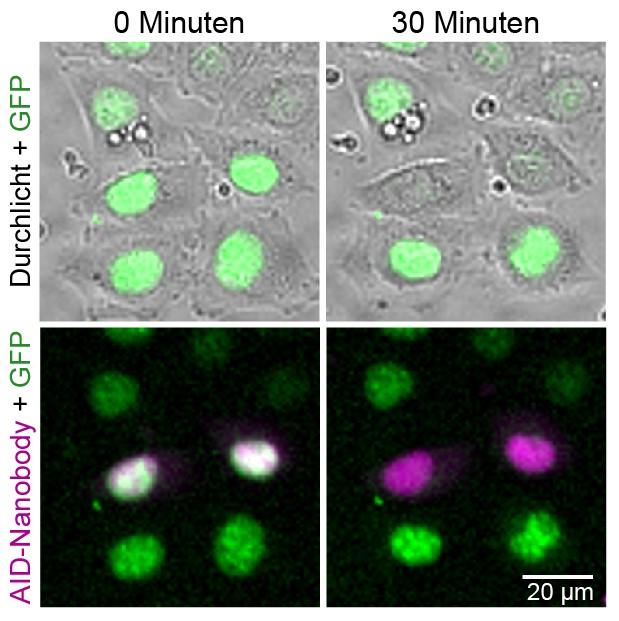
This is a microscopic image of living HeLa cells containing a GFP-linked protein (green) and the AID nanobody (magenta). After addition of the plant hormone auxin, the GFP-linked protein is broken down specifically in the cells containing AID nanobody within 30 minutes.
They combined auxin-inducible “protein knockdown” with a synthetic antibody to not only observe fluorescent proteins in living cells but also to rapidly remove them in a temporally controlled manner.
Perhaps the most important basic component of all cells are proteins that perform a wide variety of functions in cells and tissues. In order to clarify the physiological roles of proteins, they are often linked to a green fluorescent protein (GFP) via targeted genetic manipulation, which makes them visible under the microscope. The observation of such GFP-linked proteins in living cells allows initial conclusions about the function of the protein. However, the exact function of a protein can often only be determined when the protein is removed and the resulting consequences become visible in cells, tissues or model organisms.
This is usually achieved by knockout of the protein on the genetic level. However, the functions of essential proteins cannot be examined in this way, because the cell or the model organism would not be viable. Instead, an approach is needed that allows removing proteins from cells only at a specific time. Such a targeted temporary degradation of proteins occurs naturally in plants and is mediated by the plant hormone auxin. After genetic manipulation, the underlying mechanism can also be applied to animal and human cells.
Dr. Jörg Mansfeld’s research group has developed a novel AID-nanobody in order to not only observe GFP-linked proteins in living cells, but to also rapidly degrade them in a targeted manner for functional analysis. For this purpose, the auxin recognition sequence (AID) was linked to a GFP recognizing antibody that is structurally-related to camelid antibodies (nanobody). It could be shown that this so-called AID-nanobody allows the almost complete degradation of GFP-linked proteins in human cell culture after the addition of auxin. The possibility to follow the degradation of the protein “live” under the microscope makes functional analysis much easier.
In collaboration with the research group of Dr. Caren Norden, it was shown that the AID-nanobody can also be successfully used in the model organism zebrafish. Using the AID-nanobody in zebrafish demonstrated for the first time that an auxin-mediated protein knockdown can also be implemented in a complex vertebrate model.
“Our work is an excellent example of biotechnology, in which different naturally occurring principles such as fluorescent GFP from algae, auxin-dependent protein degradation from plants and the nanobody from camelids are combined to answer previously inaccessible research questions,” said Dr. Katrin Daniel from the Mansfeld Lab, commenting on the results of the research project.
The successful work highlights the synergies that can be achieved, when groups from different research institutes at the Dresden Science Campus work closely together.




